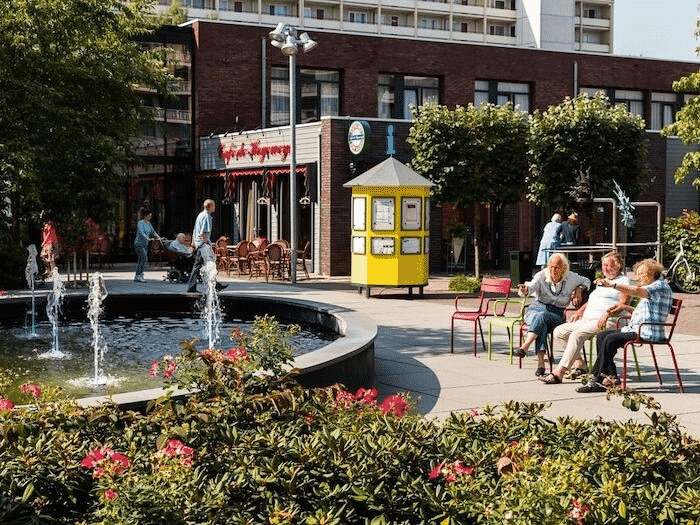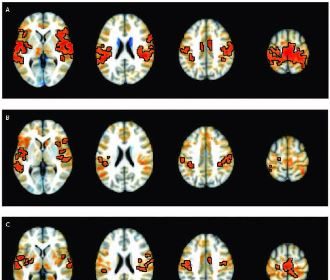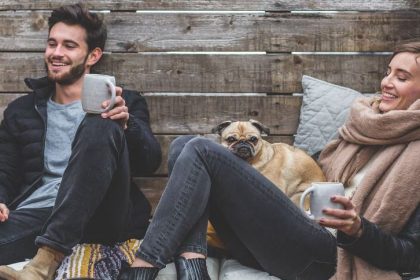Village Designed for People With Dementia Reforms Traditional Nursing Homes

WEESP, Netherlands — Thirty years ago, the Hogeweyk stood as a four-story tower operating as a traditional nursing home in an industrial area about 17 miles outside of central Amsterdam in the Netherlands.
“The way we delivered care back then, we weren’t happy with the outcomes, and we asked the honest question of, ‘What would I want for myself if I grow old and get affected by dementia?’” said Iris van Slooten-Klarenbeek, advisor at Be Advice at the Hogeweyk® Care Concept, during a zoom interview with The Well News.
In 2002, Jannette Spiering, the senior managing advisor on the Hogeweyk Care Concept and founder of the vision for the village, worked with her team to demolish the four-story building and begin the process of designing and creating an outdoor and indoor environment that could provide a normal life for people living with dementia.
The site became operational in 2009 and since then has served as a home to a total of 169 residents, with about 40-50 new residents a year.
There is only one entrance and exit to the Hogeweyk, and passing through the main door the site appears to be a traditional Dutch village with a fountain flowing in the city square, a restaurant, a post office, a theater, grocery store and a series of brick homes.
But inside the 27 homes are about six to seven residents, each living with severe dementia, many of whom will live the remainder of their days at the Hogeweyk.
“We often say that we have a back stage and front stage. In the front stage, we want to be the normal neighborhood, and we are a normal neighborhood, and hopefully you wouldn’t see the nursing home, but would see that on the back stage part,” said van Slooten-Klarenbeek.
Funding to run the site comes from the government of the Netherlands, which provides a budget per resident per day through the national health insurance system, and also a small payment from residents, typically determined by income or assets.
There are about 200 total staff that provide services to the residents of the village, with 170 members who work in providing medical care services and 30 who work in cleaning or other site services.
According to van Slooten-Klarenbeek, the professional care team consists of highly skilled nurses, psychiatrists, social coaches, nutrition specialists, physical therapists, and other care providers available to residents 24/7.
The care is provided to residents as if they were in their own home.
“Dementia causes fear, restlessness, aggression, all those things. It has a big influence on what we do, on our behavior. If you were locked up inside, you would go mad too. If something was on the radio all day, it would irritate you and you wouldn’t have the ability to say, ‘I’m going to turn it off,’” said van Slooten-Klarenbeek.
More than 55 million people globally are living with dementia, which occurs as a loss of cognitive functioning that affects memory, language and problem-solving skills, interfering with the ability to carry out activities of daily life.
According to a fact sheet from the World Health Organization, “Many people living with dementia are frequently denied the basic rights and freedoms available to others, which often leads to the use of physical and chemical restraints in care homes for older people and in acute-care settings, even if regulations are in place to protect the rights of these people and their freedom and choice.”
This was a primary problem that creators of the Hogeweyk sought to solve by giving those living with dementia greater freedom and control over how they choose to live their daily lives.
“Residents can leave their own front door and go out without having someone by their side who supervises them. They experience a lot of freedom and autonomy, and that’s something that makes them people,” said van Slooten-Klarenbeek.
Van Slooten-Klarenbeek said that the staff designs an individual treatment plan for each resident. Some residents go to the supermarket to select their own groceries, accompanied by a professional, and cook their own meals, or select what music they wish to play.
“Being able to make those choices sounds simple for you and me, but in a traditional nursing home, that is not so simple. Maybe they want to help prepare food because that’s what they did all their life. A lot of those are basic, simple choices and that is what is a part of being a free human being that is taken away in normal nursing homes,” continued van Slooten-Klarenbeek.
Inside each home is a fireplace, a long hallway and a massive living room with a dining corner. Residents can sit in the living room and engage with digital devices to stimulate cognition, such as musical instruments, robot cats and dogs or tables that work with digital impressions to play games.
Residents also have the option to participate in over 35 social clubs in the village, such as swimming, cycling or a tennis club.
In the summer, van Slooten-Klarenbeek said residents are often seen sunbathing near the duck pond in one of the lush gardens, or relaxing in the gazebo in the center square surrounded by fresh roses.
Most residents can travel outside the village to visit a family member, and in some cases, the care team has provided residents with watches that have GPS tracking devices to keep tabs on their whereabouts outside of the village.
Hogeweyk is also open to tourists, with typically about 200-250 visiting groups per year, but during the pandemic visitors have been limited.
“The first wave when it hit us was harsh, you didn’t know what to expect,” said van Slooten-Klarenbeek.
Van Slooten-Klarenbeek said at that time, the government restricted families from visiting the Hogeweyk, but during the second wave of infections the village was allowed to decide for themselves whether visitors should be allowed on site. The team also vaccinates nearly every resident and performs routine COVID testing.
“This is far more difficult in traditional nursing home areas; we have all these separate homes. So, if you have suspicion of infection, you can quarantine in one house, but all the other houses and residents can continue their lives and go on and enjoy what is there,” said van Slooten-Klarenbeek.
Even prior to COVID-19, the Hogeweyk model received acclaim from other retirement homes and communities seeking to similarly transform their health care models.
This is why five years ago the Hogeweyk created an independent team of consultants called “Be Advice” to help guide other health care organizations around the globe in reforming traditional nursing home practices.
“We were one of the early adopters of different ways of care, and we saw that a lot of other traditional types of nursing homes and health care organizations were looking at what we’re doing and were interested,” said van Slooten-Klarenbeek.
Van Slooten-Klarenbeek noted since the creation of the Be Advice team they’ve worked with a number of facilities looking to transform practices in the U.S., such as a recent project in which the team helped to reform a day care center for those living with dementia in South Bend, Indiana.
“It takes a lot of time to go from an idea and being inspired, to really accomplishing what they have in mind,” said van Slooten-Klarenbeek.
Alexa can be reached at [email protected]
























